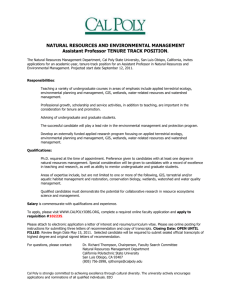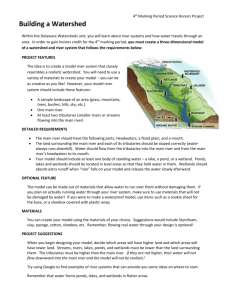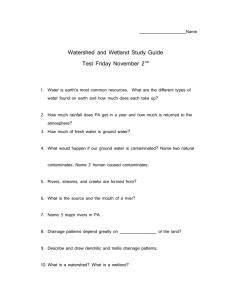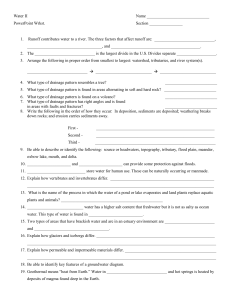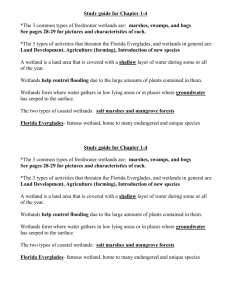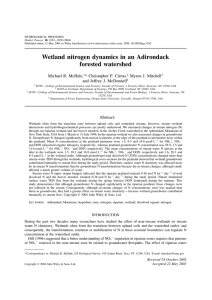Environment & Ecology Series - Department of Ecosystem Science
advertisement
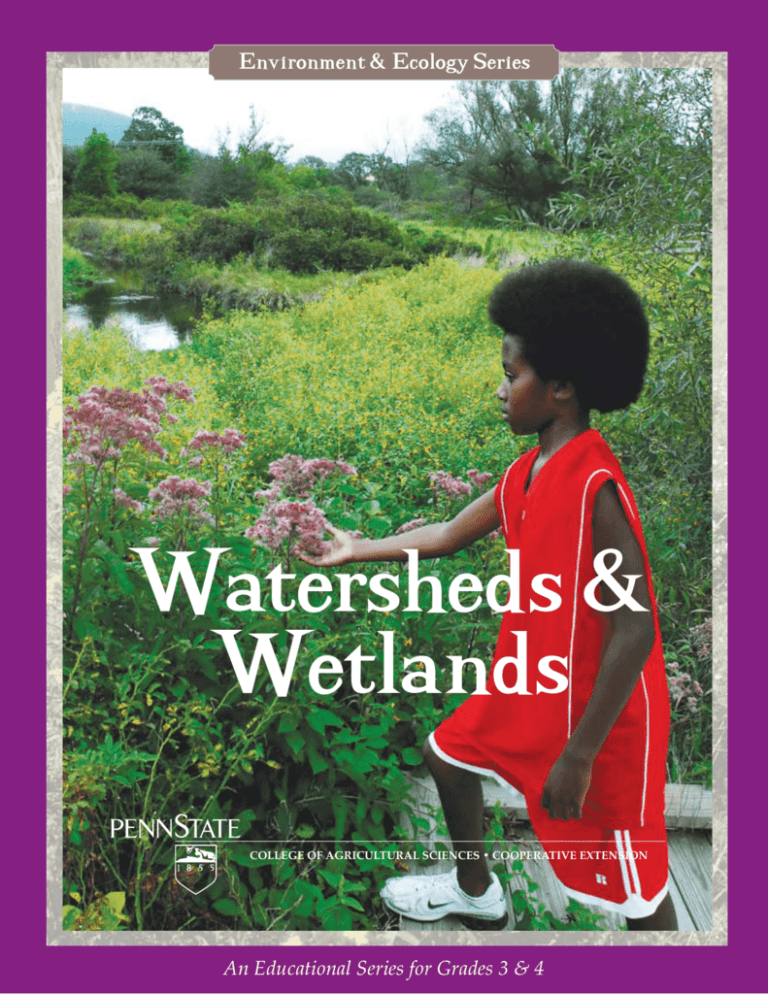
Environment & Ecology Series Watersheds & Wetlands College of Agricultural Sciences • Cooperative Extension An Educational Series for Grades 3 & 4 W ater is one of the most important substances on Earth. It is part of all living things. Every animal needs water to move food in its body and to help its organs work. Every plant needs water to move nutrients in its roots and stems and to make food in its leaves. Plants use water to make food for people. Water also helps keep people clean and healthy. Can you survive without water? Water is in many nonliving things too, such as creeks, rivers, and streams. We call these things waterways. Waterways are moving (or lotic) waters. Water in creeks, rivers, and streams flows to lower ground. Some water stays still or almost still. Still (or lentic) waters include ponds, lakes, and swamps. Still water cannot move because soil and rocks usually hold it in one place. Still water is also called standing water. Moving and still waters differ in many ways. They can differ from each other in temperature, cleanliness, and clarity. For example, moving water sometimes has small pieces of soil in it called sediment. Sediment can come from the banks of a stream or a field. Moving water is usually cooler than still water. Still water often stands in the sun and gets warmed up. Moving and still waters differ in the kinds of living things in them. Some plants, such as watercress, need water that flows over them. Other plants, like pondweed, thrive in standing water. Many insects and fish need moving water to bring them food. Other insects and fish like to move about and find their meals in still water. Which type of water would you prefer to drink from: moving or still? Why? Another place to find water is in the sky! Clouds are mostly wet air. Precipitation is the water that falls from clouds. Precipitation includes rain, mist, sleet, snow, and hail. It falls from clouds to the ground when weather conditions are right. If the sky temperature is cold, at or below 32°F (0°C), precipitation will fall as snow or sleet. If the sky temperature is warmer, precipitation will be rain or mist. Water moves around the earth in clouds. It also moves in the oceans. These movements are part of the water cycle. There are two more places to find water: wetlands and watersheds. Wetlands are places where the soil holds water and the plants prefer wet conditions. A wetland may hold water all year long or only for short periods. Wetland water may be visible, or it may be below the surface of the ground. Bogs, Taking a closer look at the plants and animals that live in wetlands can reveal many things. Cattails (left) produce thousands of seeds that spread by wind and water, and turtles (right) have scaly legs shaped like paddles for swimming. swamps, and marshes are all special kinds of wetlands. Common plants found in wetlands are shrubs, water lilies, and cattails. Many different kinds of animals and insects live in wetlands. Some common wetland animals include frogs, turtles, ducks, snakes, raccoons, and beavers. Wetlands provide many animals with food, water, and shelter. The wetland is the animal’s habitat. Wetlands are great places to watch wildlife! Wetlands are also important for a healthy environment. They help clean and filter water that moves through them. They can also hold water back and prevent flooding. What do you like best about wetlands? A watershed is a little harder to describe. A watershed is all the land area that provides The watershed in this picture drains into the river that flows in the valley. Can you see the small streams that flow into the river? Can you see rain falling on the hills? Groundwater is in the soil and stones below the surface of the land. It is in the watershed too. What living things contain water in this watershed? groundwater Illustration by Nancy Haven; used with permission from UMass Extension water to a specific steam, lake, or other body of water. For example, a small stream that runs through a valley gets its water from the hills and land above the stream. The watershed for a stream or river may be very large. The watershed for a pond includes all the land area around and above the pond that drains water into the pond. This does not include the land below the pond that drains water away into a stream or creek. A watershed is sometimes called a drainage area, but it is more than just a place or space. A watershed includes all the living and nonliving things within it. Why? Because these things use and can hold water too. They are part of the watershed. Icicles are cold solid water! Are they moving or still water? Water is an amazing substance! Life could not exist without it. Water is almost everywhere. It is in all living things, soil, rivers, streams, ponds, wetlands, and watersheds. Water makes us who we are, rains on our heads, and connects us to the world. The water we have today is what was here in the past and what will be here in the future. We must do our best to keep it clean and use it wisely. Written by Sanford S. Smith, extension specialist in Natural Resources and Youth Education, Penn State School of Forest Resources Drawings by Nora Serotkin; photos by Trevor Smith and Howard Nuernberger Be sure to visit sftrc.cas.psu.edu/EnvSeries.htm for more flyers in the Environment & Ecology Series and lesson plans for each flyer too! Visit Penn State’s College of Agricultural Sciences on the Web: www.cas.psu.edu Penn State College of Agricultural Sciences research, extension, and resident education programs are funded in part by Pennsylvania counties, the Commonwealth of Pennsylvania, and the U.S. Department of Agriculture. This publication is available from the Publications Distribution Center, The Pennsylvania State University, 112 Agricultural Administration Building, University Park, PA 16802. For information telephone 814-865-6713. This publication is available in alternative media on request. If you look under stones in the water, be sure to put them back. Many living things live under these stones. Can you name a few? The Pennsylvania State University is committed to the policy that all persons shall have equal access to programs, facilities, admission, and employment without regard to personal characteristics not related to ability, performance, or qualifications as determined by University policy or by state or federal authorities. It is the policy of the University to maintain an academic and work environment free of discrimination, including harassment. The Pennsylvania State University prohibits discrimination and harassment against any person because of age, ancestry, color, disability or handicap, national origin, race, religious creed, sex, sexual orientation, gender identity, or veteran status. Discrimination or harassment against faculty, staff, or students will not be tolerated at The Pennsylvania State University. Direct all inquiries regarding the nondiscrimination policy to the Affirmative Action Director, The Pennsylvania State University, 328 Boucke Building, University Park, PA 16802-5901; Tel 814-865-4700/V, 814-863-1150/TTY. Produced by Ag Communications and Marketing © The Pennsylvania State University 2007 Code # UH184 10M10/07acg4774


